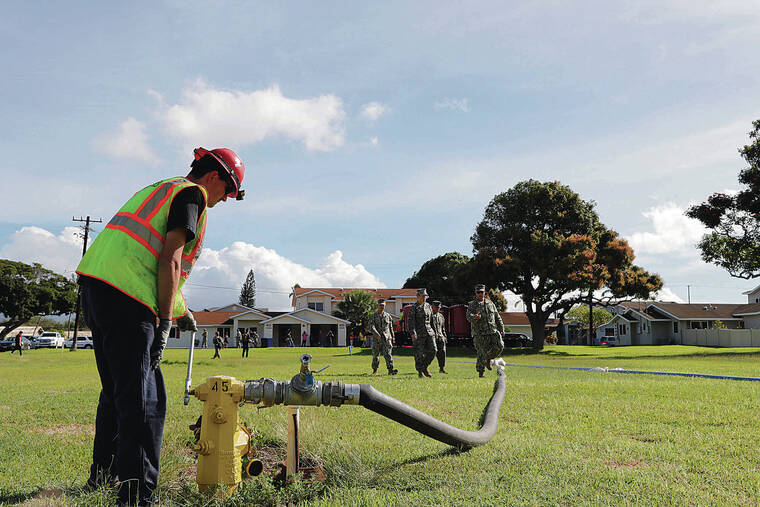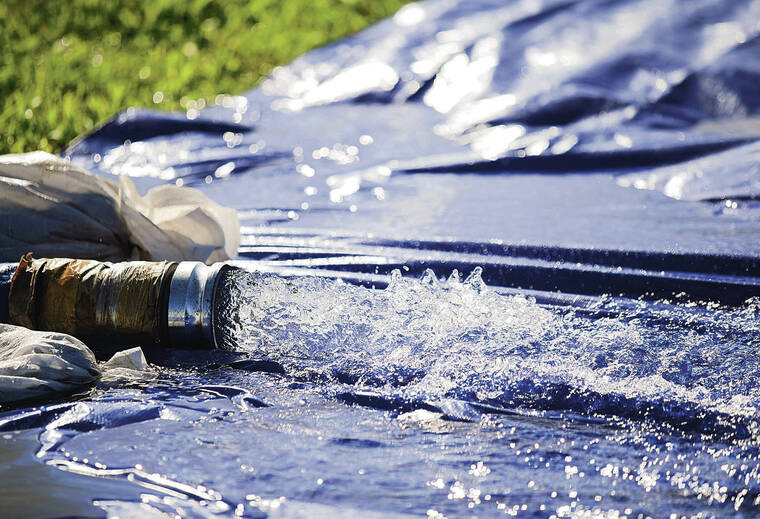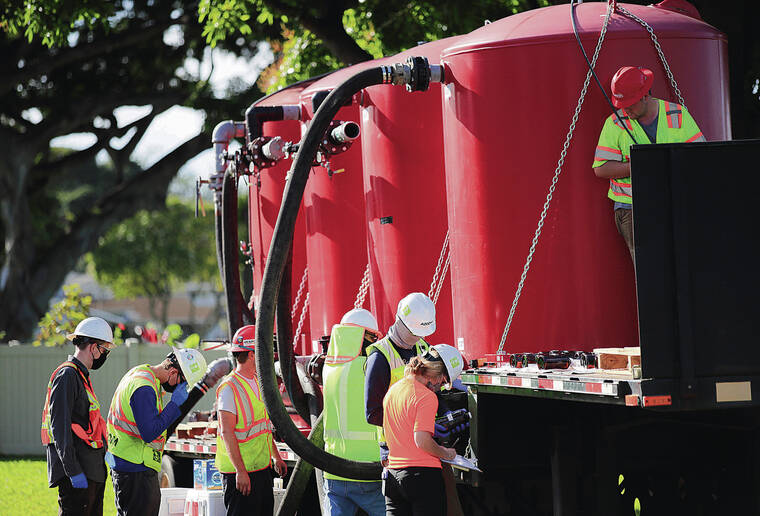The Pentagon’s Inspector General’s
Office announced Monday it will launch an investigation into the operations, maintenance and safety of the Navy’s underground Red Hill Bulk Fuel Storage Facility.
Hawaii’s congressional delegation called for the Pentagon’s Inspector General’s Office to investigate amid a crisis caused by the contamination of the Navy’s water system by fuel that apparently came from the Red Hill facility, which sits above a critical aquifer that provides water for much of Honolulu. The Navy’s water system serves 93,000 people on Oahu, and the contamination has made the water unusable for thousands of military families displaced from their homes around Joint Base Pearl Harbor-Hickam. Many surrounding businesses and schools also can no longer safely use the water.
Pentagon Assistant Inspector General Randolph Stone disclosed the investigation in a memo to the offices of the secretary of the Navy and the director of the Defense Logistics Agency.
The announcement came as Navy personnel resumed flushing the water system, and during a state hearing in which the Navy is fighting an emergency order from Gov. David Ige to remove the fuel from Red Hill until the military can prove the facility can safely operate.
The fuel storage facility was built underground during World War II to make it harder for enemy forces to strike, but its unique architecture has led to maintenance and
repair challenges for the 20-tank facility, which can hold up to 250 million gallons of fuel.
“The objective of this evaluation is to determine the extent that Navy officials managed the operation, maintenance, safety, and oversight of the Red Hill Bulk Fuel Storage Facility, and protected the environment and drinking water systems, in compliance with federal and state regulations and (Department of Defense) policy,” Stone’s wrote in the memo. “We may revise the objective as the evaluation proceeds.”
Meanwhile, in Pearl City, Navy officials and state personnel along with contractors from AECOM and Clean Harbors Inc. began using newly delivered granulated activated carbon filtration systems — or GACs — to extract water from a hydrant in a housing area as the flushing process continues. The Navy has an emergency contract for 25 of the large devices. It’s a process that officials say will take time and will have to be methodical.
“We’re talking 30 to 45 days, and that comes in multiple steps,” said Lt. Cmdr. John Daly, an engineering officer working on the Navy’s response efforts.
The filtered water extracted from a house was released into a nearby grassy field. According to officials, GAC-filtered water can be safely returned to the environment.
“We’re really excited that we’re able to get started, but more importantly, we’re here to make sure that all the plans that were executed by the Navy and the Army are actually being carried out as agreed upon by the state agencies and the federal agencies,” said Matthew Kurano, an environmental health specialist with the state Department of Health. “It’s really important that everything that’s done is done in a safe way for the environment and to protect human health.”
Earlier in the crisis, Navy officials initiated flushing directly from hydrants as a means to clear water mains, but on Dec. 11 the DOH issued a cease-and-desist order, saying the Navy wasn’t following state guidance and not properly cordoning off areas. In response the Navy ceased flushing and put in an emergency order for the GACs.
But Kurano stressed that his team has a good relationship with Daly’s team and is in constant communication. Both said that there will be constant testing and evaluations along the way.
“If any of the portions of it test unsafe, we will have to regear, but that’s why we’re saying we’ve got several opportunities to test and ensure you know that we’re on track for what we’re doing,” said Daly. “So I’ll say it’s conditions-based, we’re not just going to say it’s complete at the end of 45 days. We’re going to stay until the job’s done.”
Top Navy officials now say they think a Nov. 20 spill of JP-5 jet fuel from Red Hill is the cause of the contamination but insist it was an isolated incident. But emails leaked to local media in the weeks leading up to the incident showed that Navy officials sought to downplay safety concerns and keep issues internally raised by Navy personnel from becoming public.
The Red Hill facility was built to support the Navy’s Pacific Fleet. Today the Pentagon considers the Pacific its top priority theater of operations as tensions rise in the waterways that connect Asia’s growing economies to the global market. In particular, tensions have arisen in the South China Sea, a critical waterway through which at least one-third of all international trade passes.
The Pacific Fleet has argued that the Red Hill facility is critical to maintaining military readiness and conducting operations.
But the aging facility has had a history of concerns about leaking pipes and corrosion, and the military has spent millions on upgrading the fire suppression system.
After confirming the contamination of its water system, the Navy sent a team of salvage divers into its Red Hill water well to gather samples and work on removing contaminants.
Daly said some of the newly arrived GAC systems are set to play a role in efforts at the well while others flush neighborhood systems.
“It’s not just recovery of the drinking water system; (it’s) recovery of the wells. I think that this is a bigger job,” said Kurano. “That’s going to take a much longer time, but we are concerned with the totality of our drinking water system, not just what’s in the distribution systems.”
Recent tests from a lab contracted by the Navy showed that the level of fuel contamination in the water system itself is now below the state’s “environmental action limit,” or the level in which the government is required to act. But Daly said the job will continue until there’s no contamination.
“There’s no safe amount of JP-5 in drinking water,” said Daly, whose family lives in housing affected by the contamination.
Stone’s memo said that as part of the Pentagon probe, investigators will “perform the evaluation at the Department of the Navy, including the Navy Installations Command; Naval Facilities Command; Naval Supply Systems Command; and Joint Base Pearl Harbor-Hickam. Additionally, we will perform the evaluation at the Offices of the Under Secretary of Defense for Acquisition and Sustainment, the Under Secretary of Defense for Personnel and Readiness, and the Defense Logistics Agency. We may arrange visits to other organizations and locations.”






